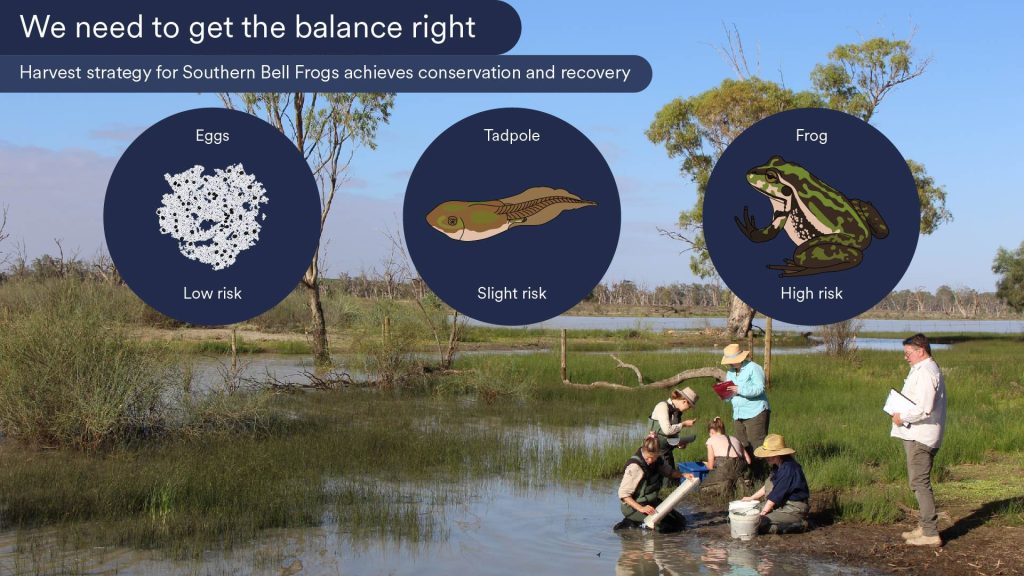Volunteers and government ecologists from the Murraylands and Riverland Landscapes Board completing a tadpole survey at Overland Corner wetland in South Australia. Several of these southern bell frog tadpoles were transferred to the hatchery run by the ‘Help the Southern Bell Frog Bounce Back’ program.
Frogs belong to a group of animals called amphibians – the most endangered group of species on the planet. Two out of every five amphibian species are currently threatened with extinction, and this figure is rising.
In a bid to help save a threatened Australian frog species – and potentially other amphibian species – scientists led by Flinders University experts have developed a new way to improve collection methods of wild frogs for breeding in captivity or to release at a new location.
The study used virtual frog populations to test different approaches and find the safest conservation strategy, says Flinders University PhD Candidate and Australian frog expert Rupert Mathwin, first author of a new article explaining the study in Austral Ecology.
“Frogs are in trouble all over the world and we need to act now. Developing safer ways for scientists and conservationists to do their important work is a critical step towards saving these species,” he says.
“Many conservation programs collect animals from the wild for these purposes but the number of animals that can be safely collected has been mostly guesswork.
“Until now, conservationists had no clear guidelines for safe collection, which made collecting new animals potentially a dangerous operation.”
To test the new approach, researchers focused on Australia’s southern bell frogs (Litoria raniformis), one of Australia’s Top 100 priority threatened species which already are the focus of two conservation breeding programs, to release more animals to the wild.
Mr Mathwin and colleagues built three frog population simulators, each tuned to a specific southern bell frog population (one in New South Wales, one in Victoria and one in South Australia). This allowed them to collect virtual eggs, tadpoles and adult frogs to see how each population responded to collection.
“Each population had its quirks, but it was clear that collecting tadpoles or frog eggs, rather than adults, had the lowest impact on the wild populations. Interestingly, it wasn’t the size of the population that determined how many animals could be collected, it was how often the population received water,” he says.
Freshwater ecologist Mr Mathwin says many people do not realise how threatened frogs can be, so he warns against removing them from the wild.
Australian Frog Expert Rupert Mathwin
“Taking southern bell frogs from the wild is illegal without a permit but anyone can get involved by supporting programs such as Help the Southern Bell Frog Bounce Back and Taskforce Growler to do this important work,” he says.
“Community groups that care for wetlands and waterways also play a critical role in saving our frogs.
“Finding better ways to support these fascinating creatures in the modern world requires a range of conservation strategies and our approach is an important step in this global journey.”
Senior author, Matthew Flinders Professor of Global Ecology Corey Bradshaw, says: “Frogs are like the canary in the coalmine, and when they start to disappear, it’s a sure sign that these systems are in trouble.
“For many species, human intervention is the only way to save the species from extinction.
“Captive breeding programs are increasingly used in frog conservation and this approach can be modified for any species.”
Human activities are impacting frogs in many ways, including via climate change, excessive water use, habitat modification and pollution.
“Using mathematics in conservation makes decision-making more efficient and effective, with applications to everything from saving threatened species to the removal of harmful invasive organisms,” says Professor Bradshaw.
“For too long, realistic models for conserving many threatened frogs have not been available. We’re changing that.”
The article, Modelling the sustainable harvest of wild populations for the conservation of a threatened amphibian (2024) by Rupert Mathwin, Skye Wassens, Anna Turner, Geoffrey W. Heard, Andrew Hall and Corey JA Bradshaw, has been published in Austral Ecology. First published: 27 February 2024 https://doi.org/10.1111/aec.
Acknowledgements: This study was supported by the Murraylands and Riverland Landscape Board, the Commonwealth Environmental Water Office and Coliban Water.
Plants, seeds & more delivered to your door!
www.nativeshop.com.au
Advertisement





